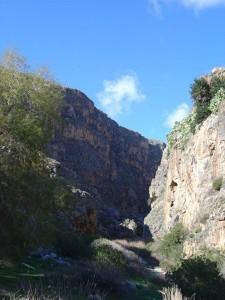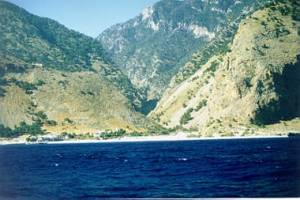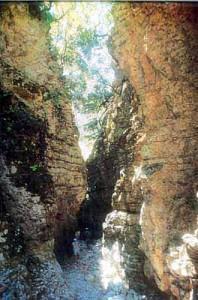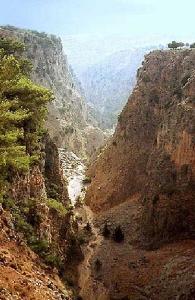Chania Gorges
Chania is a blessed and privileged place with a mild climate during the entire year, countless beauties, and all kinds of attractions. Apart from its five hundred villages, the area counts more than one hundred very clean beaches on the northern and southern coasts, one hundred mountaintops, and fifteen hundred caves, as well as countless monuments and gorges of incomparable rugged wilderness, some of the most beautiful in all of Europe. More than sixty small and large gorges, some easy and some difficult to access, are situated in the Prefecture of Chania, and that is why it is called “The Locus of Gorges.”

These gorges, with their wild beauty and unpolluted environment, stir strong emotions of awe and wonderment. The passage through one of these gorges offers unforgettable experiences and certainly leaves you with the desire to cross another gorge during your next visit to Chania.
Apart from its wilderness and beauty, Chania presents a number of other interests as well, including legends about dragons and fairies, and about the good and bad spirits that dwell in the gorges. There are limpid water springs or picturesque Byzantine chapels in such places where famous oracles or sanctuaries formerly used to function.
There are heroic stories about rebels who, debouching from these gorges, drove the Roman, Arab, Venetian, Turkish, or Nazi invaders out of the Cretan land. Dramatic stories as well, not just about heroic battles, but about thousands of women and children who found refuge in these gorges from those aggressors. Traces of their life in the wilderness are still there for the observant eye to notice: sheepfolds, watermills and sawmills, lime or coal furnaces, bulwark for defense against the various raids, secret caves, organized hideouts, etc.
These gorges were mainly formed in carbonic rock beds, i.e. limestone, marbles, and dolomites, as a result of a combination of an extensive system of deep fissures in the earth’s crust on the one hand and the corrosive activity of rain water on the other. They were formed about 14 million years ago, at the end of the Miocene Period of the Cenozoic Century.
In the following, we provide a short description with information concerning some of these gorges; this in no way means that the rest of them are devoid of beauties or of interest. Based on this information, you can choose which of the gorges you have the time or the opportunity to cross, and we wish you a nice walk.
Please contact our Agency to provide you with more detailed organizational information and help.
1. The Gorge Of Samaria
This gorge is the biggest, most imposing and most beautiful one in Chania and in Europe. It is internationally renowned and the one most often visited: more than 300,000 people a year have the pleasure of crossing it. It offers a wonderful landscape with rare geo-morphological formations. It is a unique biotope with particularly rich fauna and flora. It has a rich mythology as well, going back as far as the prehistoric years, and a tumultuous history during the difficult years of the Cretan past.
It was proclaimed a National Park (“National Park of the White Mountains”) in 1962, the date on which two or three Sfakian families still inhabited the village of Samaria, midway through the gorge, mainly busy with cattle-breeding and woodcutting.
The area of the National Park initially covered 48,500 square miles, but today it is extended to 250,000 square miles, to include the most interesting part of the White Mountains Range. The gorge was awarded, in 1971, the National Diploma of Nature Protection; in 1973, it was proclaimed a Place of Special Natural Beauty; and, in 1979, the First Order European Diploma for Protection of the Natural Environment was awarded to it by the Council of Europe, renewable every five years.
The walking passage to the end of the Park is 12,800 meters, with an additional 3,200 meters to the coast of Aghia Roumeli. If you can maintain a good pace, you can make the crossing in five hours or less. It is strongly advisable, though, to walk at a slower rate, so that it takes you around seven to eight hours, to give yourself time to enjoy its incomparable beauty. It can usually be visited from the beginning of May to the end of October, unless there are bad weather conditions prevailing. There are Forest Inspection Service guard-posts at the entrance to the gorge (the village of Samaria) and at its end. A medical doctor is also at the service of visitors to the gorge, as well as a helicopter landing spot in Aghia Roumeli.
The fauna species of primary interest is the world famous Cretan Chamois (wild goat) Capra Aegagrus Cretica, an extremely beautiful and dashing animal, now protected and having restored a viable for the species population. It is living at large in the Gorge of Samaria and the three gorges parallel to it. Among the well-known flora species, you will see the perennial gigantic Cypress trees, once used in shipbuilding and in the construction of the pillars of the Minoan Palaces in Knossos and elsewhere in Crete. There is a total of 450 species of Cretan Flora in the gorge, of which 70 are endemic, i.e. they only grow in this region.
The gorge has a lot of narrow passes, called “gates,” but the narrowest pass  , the “Iron Gate,” is 3 meters (9 feet) wide and 300 to 700 meters (900 to 2100 feet) high at both sides. Here and there you cross small wooden bridges over the river water flowing along the gorge.
In the past, there were famous sanctuaries and oracles in the gorge. In Aghia Roumeli there was the ancient city of Tara, in which there was a Temple to Apollo, only partly saved today.
You can participate in one of the excursions to the gorge organized by our Agency through our local representatives, or reach its entrance on the famous plateau of Omalos by bus. The entrance is at an altitude of 1,250 meters (3,750 feet) and at a distance of 43 kilometers (26.5 miles) from Chania. There are small taverns and hotels in Omalos and an information center as well, a kind of a small museum dedicated to Samaria and the White Mountains.
On your exit at Aghia Roumeli, you can sail onboard one of the modern vessels that will take you in one hour to Chora Sfakion, from where you can catch the bus to Chania, Rethymno, etc. There is also a westward sailing craft to the coasts of Sougia and Palaeochora. All these options are not a must: you can choose to enjoy a relaxing swim in the clean water of the Libyan Sea at the idyllic beach of Aghia Roumeli, dine at one of the numerous tavernas, and stay overnight at one of the small hotels in the area. The same choice is open for you in Chora Sfakion. Please contact us for help in organizing your Samaria Gorge Crossing!
 2. The Gorge Of Imbros In Sfakia 2. The Gorge Of Imbros In Sfakia
This is a small but wonderful gorge visited each year by approximately 50,000 people, due to being easily accessed and crossed year-round and in all weather conditions, especially appealing when the Gorge of Samaria is not open.
Its crossing starts at the Sfakian mountain village Imbros, situated at an altitude of 780 meters (2340 feet) and at a distance of 55 kilometers (34 miles) from Chania. There are also tavernas with local delicacies in Imbros. The gorge is 8 kilometers (5 miles) long, and it takes 2 hours to cross. It has impressive “gates” or entrances, i.e. narrow vertical rocky passes that, like a tunnel, almost obstruct the view to the sky in the middle of the passage, and the narrowest spot is only 2 meters (6 feet) wide.
The cross gives out to the asphalt road that connects Chora Sfakion westwards (4800 meters, 3 miles) to the reputed fortress and beach of Frangokastello (10 kilometers, 6.2 miles) eastwards. There are also tavernas at the exit.
3. The Gorge Of Aghia Eirini In Selino
On the western side of the White Mountains, in the province of Selino, another gorge opens up, unique in beauties and flora. The gorge has a lot of vertical passes and is named after the small village situated in the vicinity of its entrance, at a distance of 46 kilometers (28.6 miles) from Chania.
The Gorge is 7.5 kilometers (4.6 miles) long, and its crossing takes an average of 3 hours. At the end, there is a picturesque traditional tourist kiosk from which it will take you another 45 minute's walk to reach the littoral village of Sougia. Its beautiful beach is very clean, and you will enjoy an unforgettable swim in the waters of the Libyan Sea. There are tavernas, rooms for rent, and small hotels in Sougia. A craft sails from the port of Sougia once a day, connecting the village to Chora Sfakion eastwards and to Palaeochora westwards.
4. The Gorge Of Aradaena In Sfakia
This is one of the most interesting gorges, although it is not among the biggest. In order to reach it from Chora Sfakion, you walk the carriageway up to the mountain village of Anopoli, a distance of 12 kilometers (7 miles) and at an altitude of 600 meters (1800 feet), which is built on the southern side of the foot of the White Mountains. You then walk another 3.5 kilometers (2.2 miles) to reach the deserted village of Aradaena (at an altitude of 520 meters / 1560 feet), built on the brink of the gorge. The ancient city of Aradin used to be here. An iron bridge over the vertiginous precipice  unites both sides of the gorge. Before the bridge, on your righthand side, you will find an old stone path once leading to Aradaena. From there, you walk down to the bottom of the gorge and then, on a slightly rough terrain, to its end by the Libyan Sea. It will take you around two and a half hours but, at the end of the gorge, at the very clean gravel beach of Marmara (=Marble Stones), you can enjoy an unforgettable swim.
On your way through the gorge you will meet a 9-meter / 27-foot vertical pass where an iron ladder was formerly placed to facilitate its crossing. From the exit of the gorge to the picturesque village of Loutro (=Bath), where you can catch a boat to Chora Sfakion, you can walk for about an hour across the beaches of Lykos (=Wolf) and Phoenikas (=Palm tree). From the coast of Marmara, a little boat can take you to Loutro daily. From Loutro, you can take the boat to Chora Sfakion or, alternatively, take the two-hour walk there.
The Gorge Of Elygia
This is one of the most remarkable gorges of Sfakia, where a few couples of the Cretan Chamois wild goats still live.
Its crossing starts from the village of Aghios Ioannis in Sfakia, at an altitude of 780 meters (2340 feet) and a distance of 92 kilometers (57.2 miles) from Chania. It will take you an hour to reach the location of Kormokopos, where there are caves with water, before starting your descent down the gorge (up to this point you will need a guide).
The gorge ends, after another 2 hour's walk, at a very beautiful piney sand beach by the Libyan Sea. From the beach of Aghia Roumeli, you have to walk one more hour. The above-described crossing covers half the gorge; if you wish to cross all of Elygia, you need an experienced guide and at least two days at your disposal. You start from the plateau of Omalos and walk via the refuge of Kallergi and the summit of Melintaou (at an altitude of 2133 meters / 6400 feet) before you reach the location Potamos (=river) in the White Mountains. After a vertical descent of 10 meters (30 feet), you reach the bottom of the gorge and walk on up to the coast of the Libyan Sea. |
|



